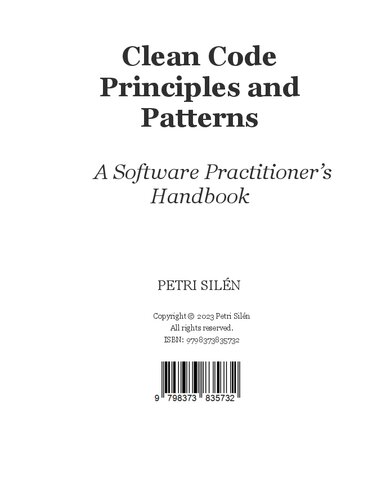

Most ebook files are in PDF format, so you can easily read them using various software such as Foxit Reader or directly on the Google Chrome browser.
Some ebook files are released by publishers in other formats such as .awz, .mobi, .epub, .fb2, etc. You may need to install specific software to read these formats on mobile/PC, such as Calibre.
Please read the tutorial at this link: https://ebookbell.com/faq
We offer FREE conversion to the popular formats you request; however, this may take some time. Therefore, right after payment, please email us, and we will try to provide the service as quickly as possible.
For some exceptional file formats or broken links (if any), please refrain from opening any disputes. Instead, email us first, and we will try to assist within a maximum of 6 hours.
EbookBell Team

4.0
16 reviewsOne of the most comprehensive no-fluff guides for software developers to help them write clean code every day. The book is packed with principles and patterns that help developers, from novices and juniors to seniors and experts, to write cleaner code.
Clean Code Principles and Patterns is one of the most comprehensive no-fluff guides for software developers to help them write clean code every day. The author Petri Silén has almost 30 years of industry experience in designing and implementing software, and now he puts all his knowledge gained during the years into this book. The book is packed with principles and patterns that help developers, from novices and juniors to seniors and experts, to write cleaner code. The principles and patterns presented in the book are accompanied by realistic yet straightforward examples to help the reader to understand them better. Examples are written in Java, JavaScript/TypeScript, and C++. Most of the examples are directly applicable to other programming languages, too. The reader should have basic knowledge of one object-oriented programming language to get the full benefit from this book.
Bying this book, you support Code Club, a global network of free coding clubs for 9–13 year olds.
The book is divided into ten chapters
Architectural design principles
Object-oriented design principles
Coding principles
Testing principles
Security principles
API design principles
Database types and related principles
Concurrent programming principles
Teamwork principles
DevSecOps
After reading this book, you will know the following and much more
How to design modern cloud-native microservices
What are autopilot microservices
What are event sourcing, CQRS, distributed transactions, saga orchestration pattern, and saga choreography pattern
What are the five SOLID principles, and how to put them into use in real-life code
What are the 25 design patterns, and how to use them
What is the MVC pattern, and how MVP and MVVM differ from each other
How to achieve a cl